Verification and Comparison of Direct Calculation Method for the Analysis of Support–Ground Interaction of a Circular Tunnel Excavation
Abstract
:1. Introduction
2. Equations Derivation of the Direct Calculation Method (DCM)
2.1. Solution for the Support-Ground Interaction under the Elastic Condition
2.2. Solution for the Support–Ground Interaction under the Plastic Condition
3. Procedure of Numerical Analysis for the Direct Calculation Method (DCM) and Finite Element Method (FEM)
3.1. Procedure of Numerical Analysis for the DCM
3.2. Procedure of Numerical Analysis for the FEM
4. Verification and Comparison of Results between This Study and Other Research
4.1. Verification and Comparison of Results between FEM and DCM
4.2. Comparison of Results between DCM and Other Studies
5. Conclusions
- (1)
- The direct calculation method (DCM) is used to study the theoretical explanation and numerical analysis of the support–ground interaction caused by a circular tunnel excavation in the isotropic stress field.
- (2)
- The DCM is proposed to provide a special algorithmic process to solve the support-ground interaction solution at the equilibrium state. The roots are obtained by applying the method of simultaneous equations in the elastic region and Newton’s recurrence method in the plastic region. DCM investigated the solution for the interaction between GRC and SCC, namely the mobilized support pressure and the radial displacement.
- (3)
- To resolve the theoretical analysis into an executable numerical program, a simple spreadsheet of calculations is used to realize the application of DCM.
- (4)
- The confinement loss as the incremental factor defining the situation of tunnel advancing excavation is classified by two cases (Case I and II) and proposed to distinguish whether the stress state is in the plastic or the elastic regions.
- (5)
- Good validation results are obtained between FEM and DCM for tunnel excavation simulations under support or no support conditions.
- (6)
- Three research results, Rocksupport (2004) [36], Oreste (2009) [6], and Gschwandtner-Galler (2012) [23], are used to compare with that obtained by DCM. In the no support condition, the consistency of the results is also very good. In the support condition, the maximum percentage error is 10%, 6%, and 4% for the mobilized support pressure, the radial displacement, and the plastic zone radius, respectively.
Author Contributions
Funding
Institutional Review Board Statement
Informed Consent Statement
Data Availability Statement
Conflicts of Interest
References
- Hoek, E.; Brown, E.T. Underground Excavations in Rock; The Institution of Mining and Metallurgy: London, UK, 1980. [Google Scholar]
- AFTES (Association Française des Tunnels et de l’Espace Souterrain). Recommandations pour l’emploi de la méthode convergence-confinement. Tunn. Ouvrages Souterr. 1983, 59, 119–138. [Google Scholar]
- Panet, M. Le Calcul des Tunnels par la Méthode de Convergence-Confinement; Presses de l’Ecole Nationale des Ponts et Chaussées: Paris, France, 1995. [Google Scholar]
- Panet, M. Recommendations on the Convergence-Confinement Method; Association Française des Tunnels et de l’Espace Souterrain (AFTES): Paris, France, 2001; pp. 1–11. [Google Scholar]
- Oreste, P. Analysis of structural interaction in tunnels using the convergence-confinement approach. Tunnell. Undergr. Space Technol. 2003, 18, 347–363. [Google Scholar] [CrossRef]
- Oreste, P. The convergence–confinement method: Roles and limits in modern geomechanical tunnel design. Am. J. Appl. Sci. 2009, 6, 757–771. [Google Scholar] [CrossRef] [Green Version]
- Sandrone, F.; Labiouse, V. Analysis of the evolution of road tunnels equilibrium conditions with a convergence-confinement approach. Rock Mech. Rock Eng. 2010, 43, 201–218. [Google Scholar] [CrossRef]
- Brown, E.T.; Bray, J.W.; Ladanyi, B.; Hoek, E. Ground response curves for rock tunnels. J. Geotech. Eng. ASCE 1983, 109, 15–39. [Google Scholar] [CrossRef]
- Brady, B.H.G.; Brown, E.T. Rock Mechanics for Underground Mining; Chapman & Hall: London, UK, 1993. [Google Scholar]
- Wang, Y. Ground response of a circular tunnel in poorly consolidated rock. J. Geotech. Eng. ASCE 1996, 122, 703–708. [Google Scholar] [CrossRef]
- Carranza-Torres, C.; Fairhurst, C. Application of the convergence-confinement method of tunnel design to rock masses that satisfy the Hoek–Brown failure criterion. Tunnell. Undergr. Space Technol. 2000, 15, 187–213. [Google Scholar] [CrossRef]
- Carranza-Torres, C. Elasto-plastic solution of tunnel problems using the generalized form of the Hoek-Brown failure criterion. Int. J. Rock Mech. Min. Sci. 2004, 41, 629–639. [Google Scholar] [CrossRef]
- Sharan, S.K. Exact and approximate solutions for displacements around circular openings in elastic-brittle plastic Hoek-Brown rock. Int. J. Rock Mech. Min. Sci. 2005, 42, 542–549. [Google Scholar] [CrossRef]
- Park, K.H.; Kim, Y.J. Analytical solution for a circular opening in an elastic–brittle–plastic rock. Int. J. Rock Mech. Min. Sci. 2006, 43, 616–622. [Google Scholar] [CrossRef]
- Guan, Z.; Jiang, Y.; Tanabasi, Y. Ground reaction analyses in conventional tunnelling excavation. Tunnell. Undergr. Space Technol. 2007, 22, 230–237. [Google Scholar] [CrossRef]
- Alejano, L.R.; Rodriguez-Dono, A.; Alonso, E.; Fdez-Manín, G. Ground reaction curves for tunnels excavated in different quality rock masses showing several types of post-failure behaviour. Tunnell. Undergr. Space Technol. 2009, 24, 689–705. [Google Scholar] [CrossRef]
- Serrano, A.; Olalla, C.; Reig, I. Convergence of circular tunnels in elastoplastic rock masses with non-linear failure criteria and non-associated flow laws. Int. J. Rock Mech. Min. Sci. 2011, 48, 878–887. [Google Scholar] [CrossRef]
- Zhang, Q.; Jiang, B.S.; Wang, S.L.; Ge, X.R.; Zhang, H.Q. Elasto-plastic analysis of a circular opening in strain-softening rock mass. Int. J. Rock Mech. Min. Sci. 2012, 50, 38–46. [Google Scholar] [CrossRef]
- Oreste, P.; Spagnoli, G. A combined analytical and numerical approach for the evaluation of radial loads on the lining of vertical shaft. Geotech. Geol. Eng. 2016, 34, 1057–1065. [Google Scholar] [CrossRef]
- Lee, Y.L. Explicit procedure and analytical solution for the ground reaction due to advance excavation of a circular tunnel in an anisotropic stress field. Geotech. Geol. Eng. 2018, 36, 3281–3309. [Google Scholar] [CrossRef]
- Lee, Y.L. Incremental procedure method for the analysis of ground reaction due to excavation of a circular tunnel by considering the effect of overburden depth. Tunnell. Undergr. Space Technol. 2019, 93, 1–16. [Google Scholar] [CrossRef]
- Oreste, P.; Peila, D. Modelling progressive hardening of shotcrete in convergence-confinement approach to tunnel design. Tunnell. Undergr. Space Technol. 1997, 12, 425–431. [Google Scholar] [CrossRef]
- Gschwandtner, G.G.; Galler, R. Input to the application of the convergence confinement method with time-dependent material behavior of the support. Tunnell. Undergr. Space Technol. 2012, 27, 13–22. [Google Scholar] [CrossRef]
- Rodríguez, R.; Díaz-Aguado, M.B. Deduction and use of an analytical expression for the characteristic curve of a support based on yielding steel ribs. Tunnell. Undergr. Space Technol. 2013, 33, 159–170. [Google Scholar] [CrossRef]
- Cui, L.; Zheng, J.; Zhang, R.; Lai, H. A numerical procedure for the fictitious support pressure in the application of the convergence-confinement method for circular tunnel design. Int. J. Rock Mech. Min. Sci. 2015, 78, 336–349. [Google Scholar] [CrossRef]
- Carranza-Torres, C.; Engen, M. The support characteristic curve for blocked steel sets in the convergence-confinement method of tunnel support design. Tunnell. Undergr. Space Technol. 2017, 69, 233–244. [Google Scholar] [CrossRef]
- Oke, J.; Vlachopoulos, N.; Diederichs, M. Improvement to the convergence-confinement method: Inclusion of support installation proximity and stiffness. Rock Mech. Rock Eng. 2018, 51, 1495–1519. [Google Scholar] [CrossRef]
- De La Fuente, M.; Taherzadeh, R.; Sulem, J.; Nguyen, X.S.; Subrin, D. Applicability of the convergence-confinement method to full-face excavation of circular tunnels with stiff support system. Rock Mech. Rock Eng. 2019, 52, 2361–2376. [Google Scholar] [CrossRef]
- Bernaud, D.; Rousset, G. The new implicit method for tunnel analysis. Int. J. Numer. Anal. Methods Geomech. 1996, 20, 673–690. [Google Scholar] [CrossRef]
- González-Nicieza, C.; Álvarez-Vigil, A.E.; Menéndez-Díaz, A.; González-Palacio, C. Influence of the depth and shape of a tunnel in the application of the convergence-confinement method. Tunnell. Undergr. Space Technol. 2008, 23, 25–37. [Google Scholar] [CrossRef]
- Mousivand, M.; Maleki, M.; Nekooei, M.; Msnsoori, M.R. Application of Convergence-Confinement method in analysis of shallow non-circular tunnels. Geotech. Geol. Eng. 2017, 35, 1185–1198. [Google Scholar] [CrossRef]
- Mousivand, M.; Maleki, M. Constitutive models and determining methods effects on application of Convergence-Confinement method in underground excavation. Geotech. Geol. Eng. 2018, 36, 1707–1722. [Google Scholar] [CrossRef]
- Vlachopoulos, N.; Diederichs, M. Improved longitudinal displacement profiles for convergence confinement analysis of deep tunnels. Rock Mech. Rock Eng. 2009, 42, 131–146. [Google Scholar] [CrossRef]
- Panet, M.; Guenot, A. Analysis of convergence behind the face of a tunnel. In Proceedings of the 3rd International Symposium, Brighton, UK, 7–11 June 1982; pp. 197–204. [Google Scholar]
- Humbert, P.; Dubouchet, A.; Fezans, G.; Remaud, D. CESAR-LCPC, un progiciel de calcul dédié au génie civil. Bull. Des Lab. Ponts Chaussées 2005, 256, 7–37. [Google Scholar]
- Rocksupport. Rock Support Interaction and Deformation Analysis for Tunnels in Weak Rock; Tutorial Manual of Rocscience Inc.; Rocscience Inc.: Toronto, ON, Canada, 2004; pp. 1–76. [Google Scholar]
- Lee, Y.L.; Lin, M.Y.; Hsu, W.K. Study on relationship between the confinement loss and the longitudinal deformation curve by using three-dimensional finite element analysis. Chin. J. Rock Mech. Eng. 2008, 27, 258–265. [Google Scholar]
- Lee, Y.L.; Hsu, W.K.; Lin, M.Y. Analysis of the advancing effect and the confinement loss by using deformation measurement in tunneling. Chin. J. Rock Mech. Eng. 2009, 28, 39–46. [Google Scholar] [CrossRef] [Green Version]
- Lee, Y.L. Prise en Compte des Non-Linéarité de Comportement des Sols et des Roches dans la Modélisation du Creusement d’un Tunnel. Ph.D. Thesis, École Nationale des Ponts et Chaussées, Paris, France, 1994. Available online: https://pastel.archives-ouvertes.fr/pastel-00569423 (accessed on 28 September 2021).
- Lee, Y.L. Explicit analysis for the ground-support interaction of circular tunnel excavation in anisotropic stress fields. J. Chin. Inst. Eng. 2020, 43, 13–26. [Google Scholar] [CrossRef]
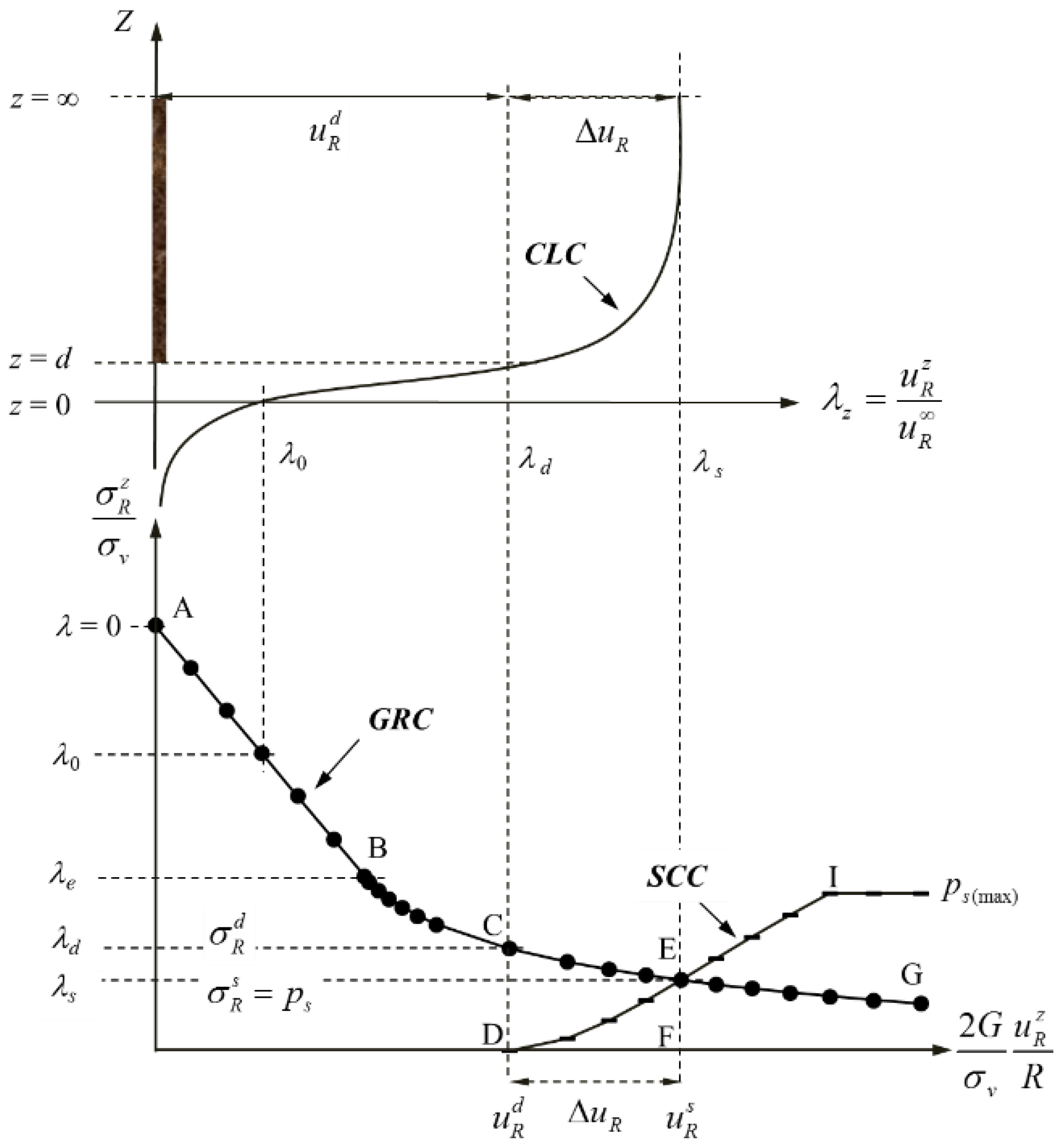

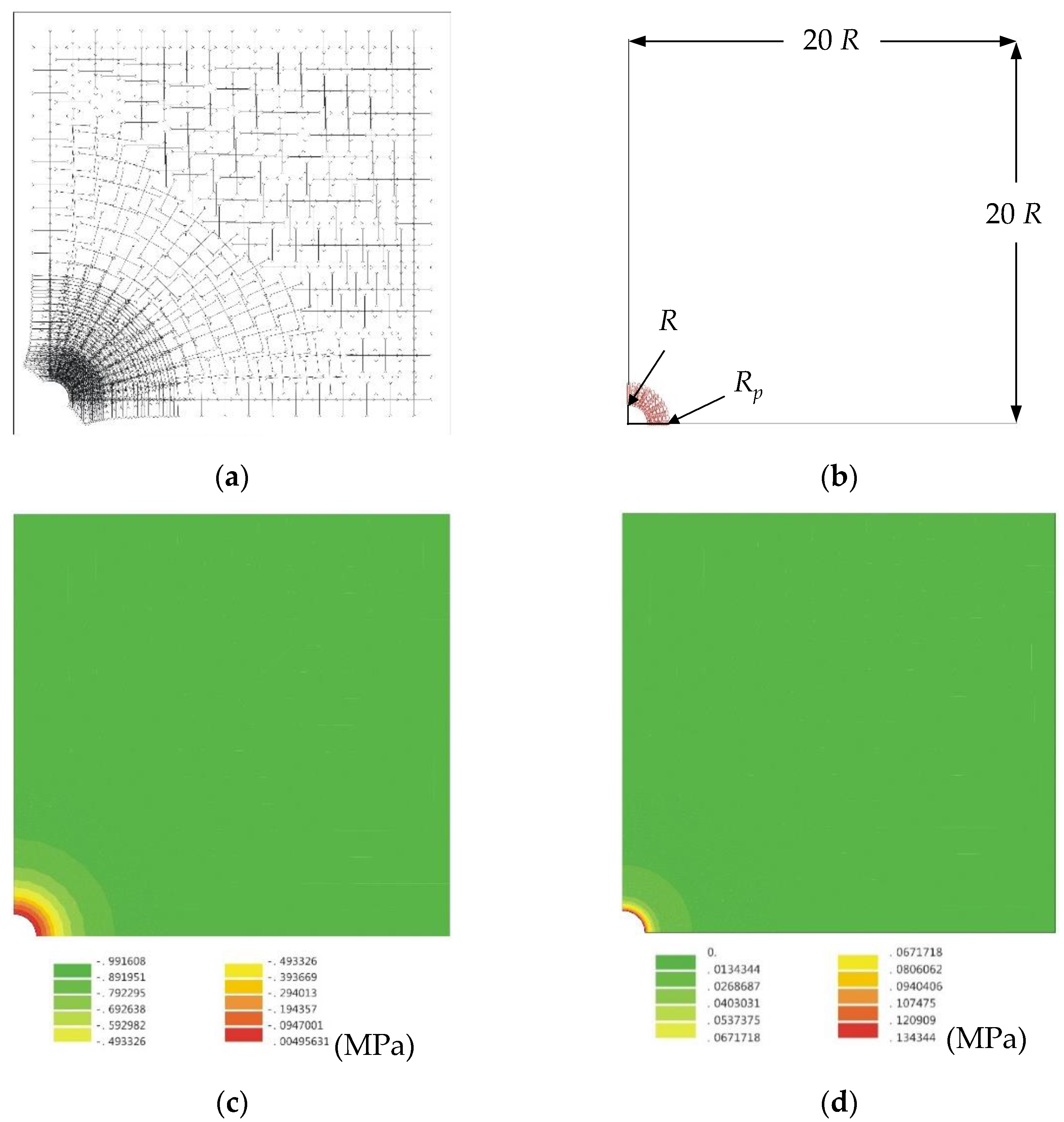
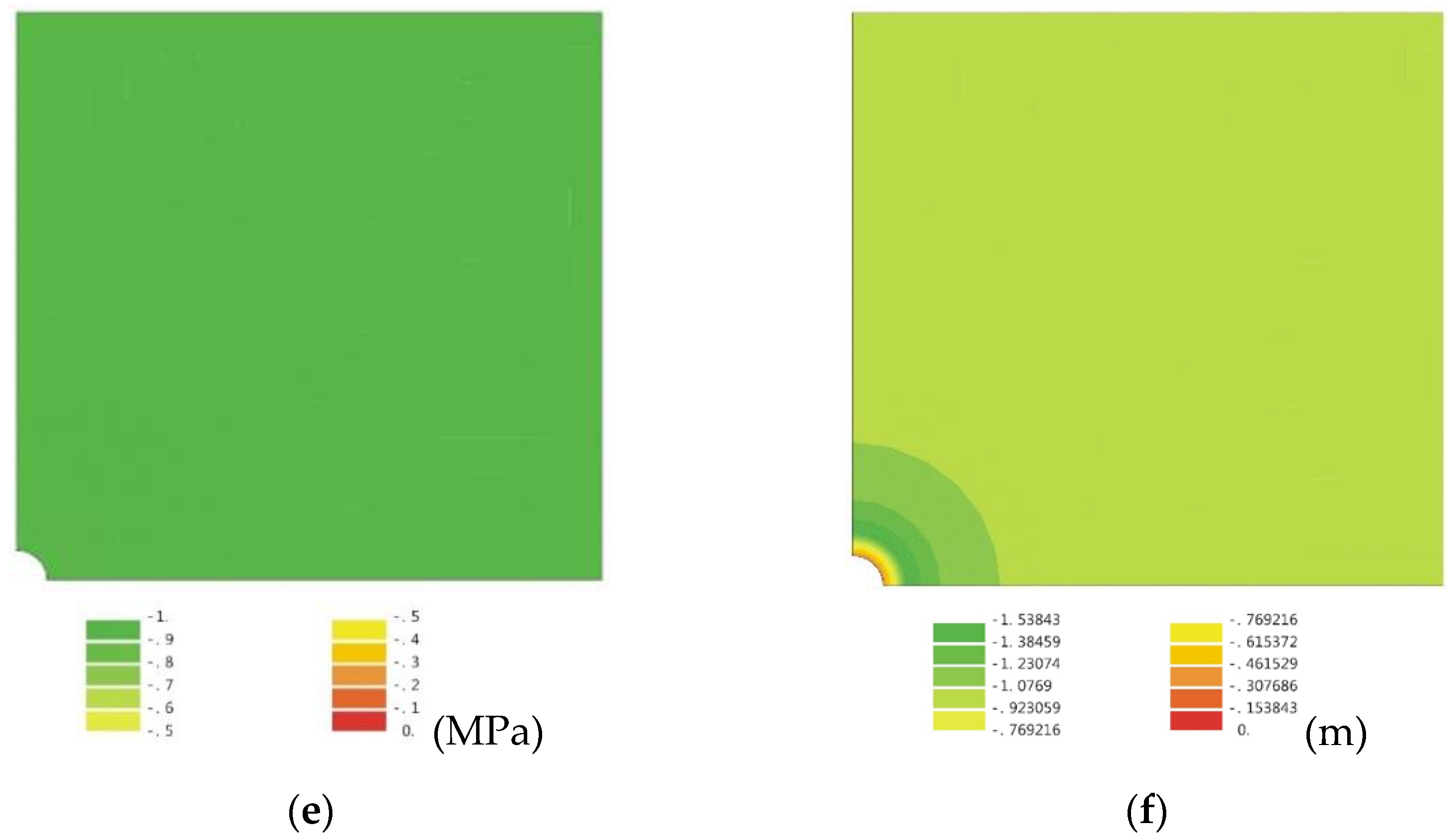
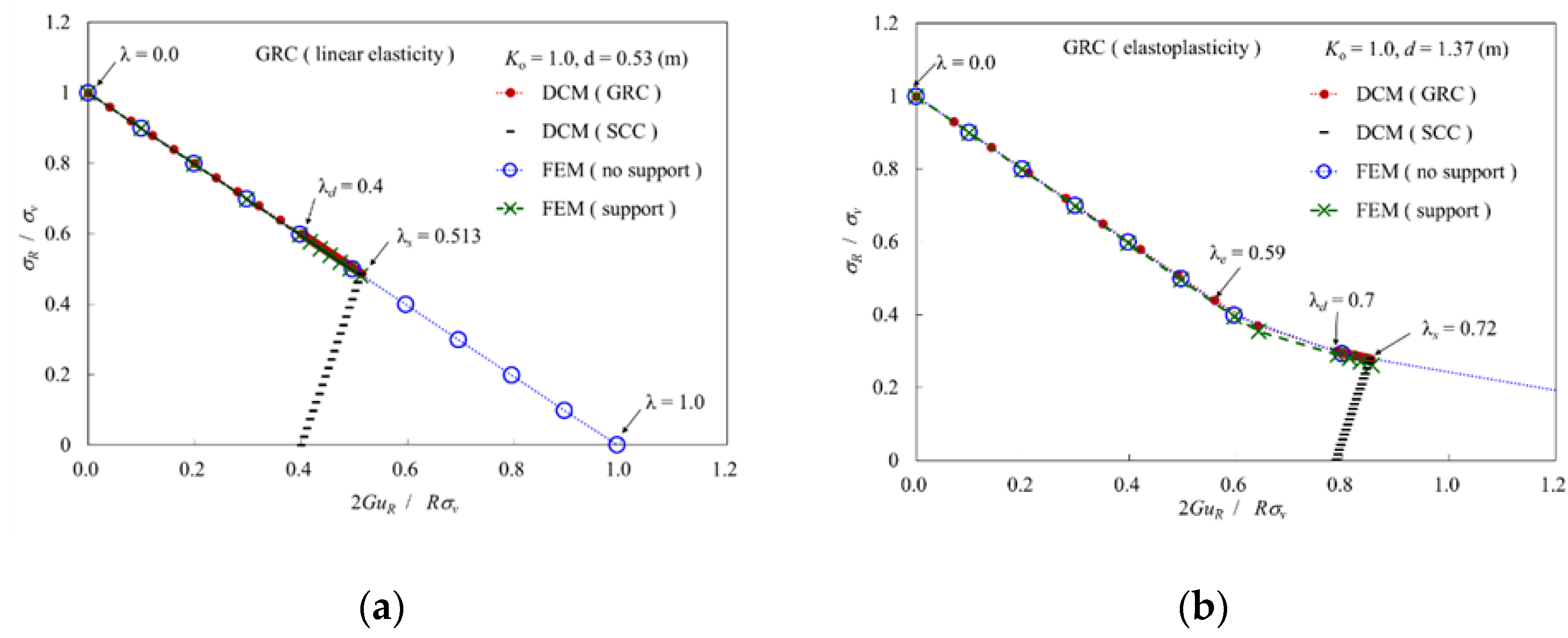
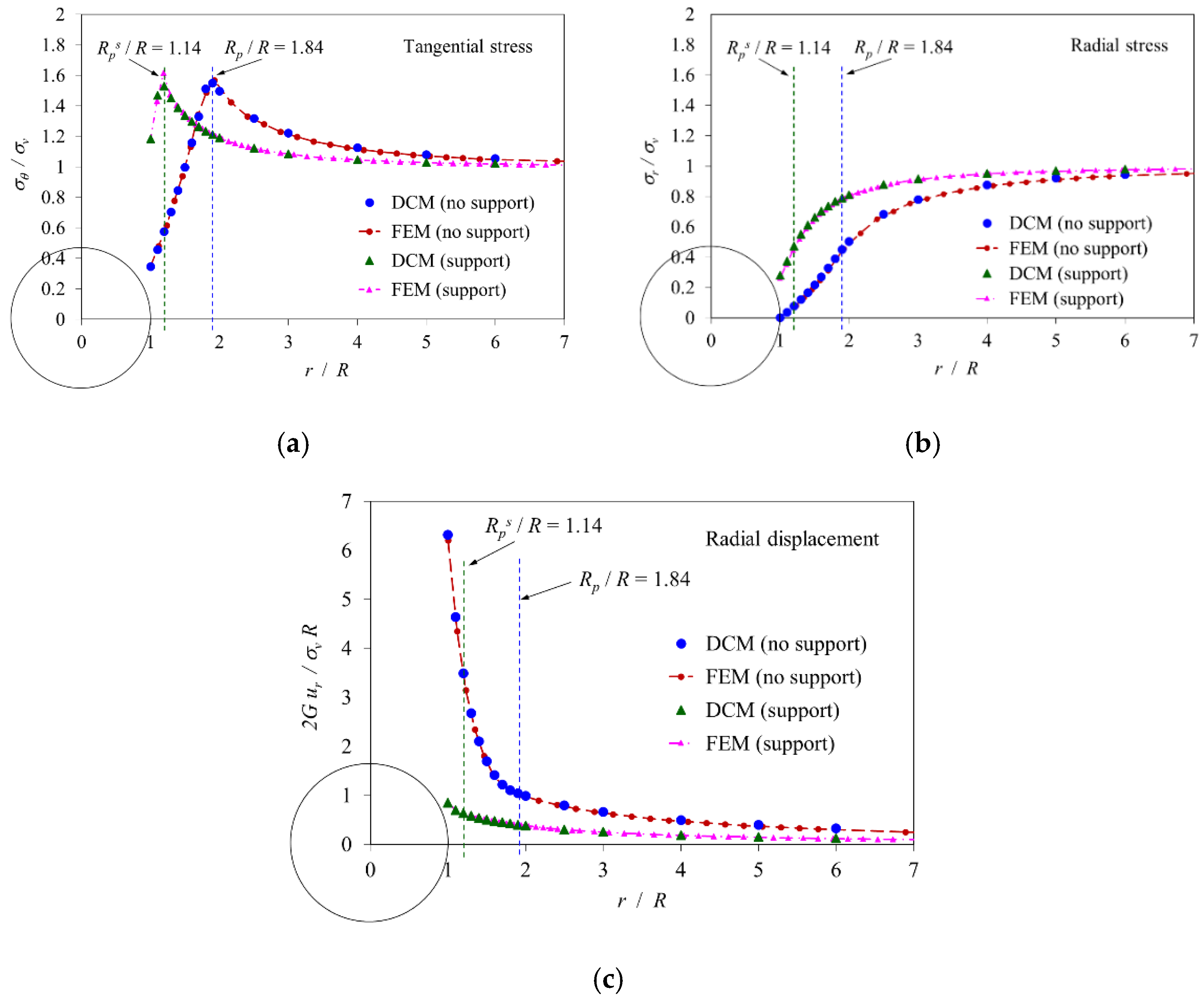
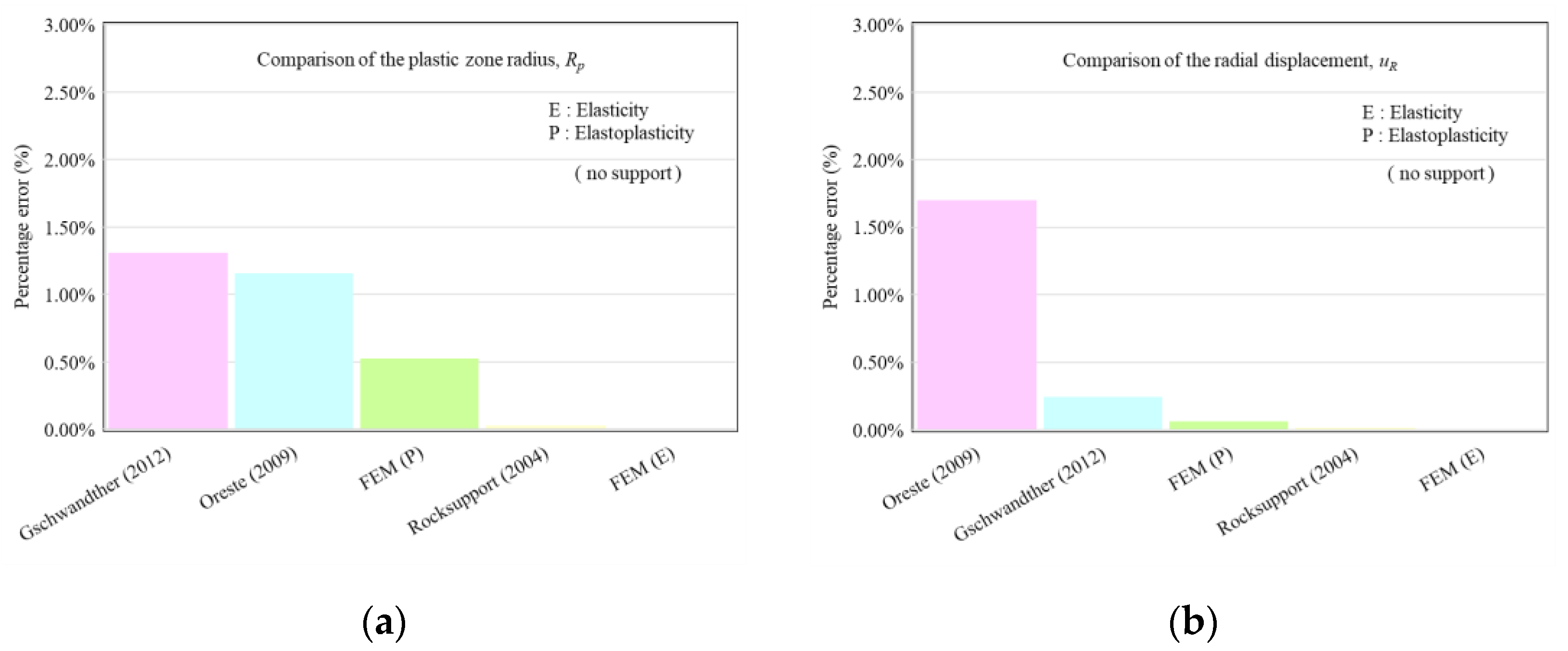
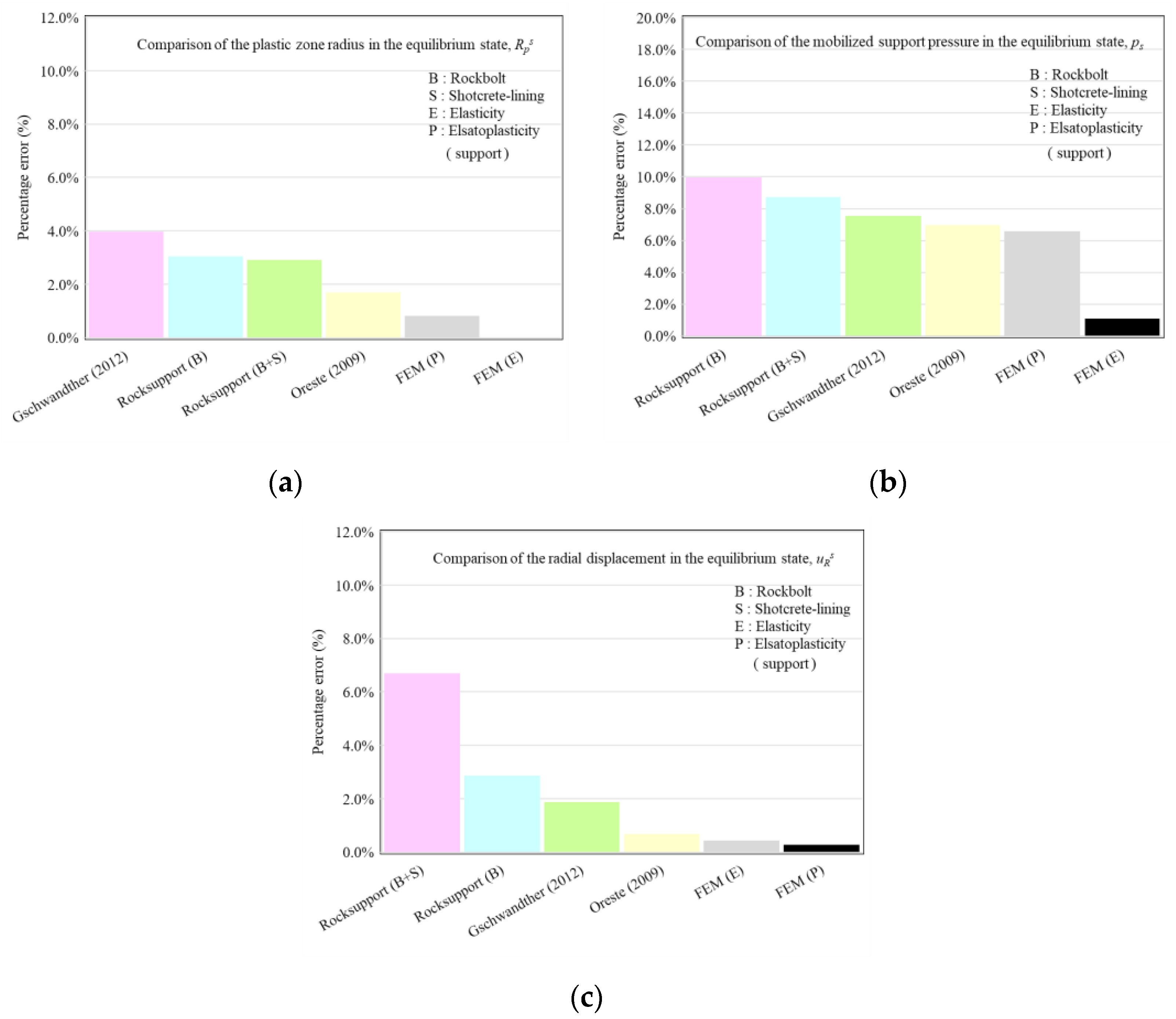
| Ground | Support (Shotcrete-Lining) | ||
|---|---|---|---|
| Parameter | Value | Parameter | Value |
| Vertical stress, σv (MPa) | 1.0 | Poisson’s ratio, νshot | 0.2 |
| In-situ stress ratio, Ko | 1.0 | Elastic modulus, Eshot (GPa) | 25.0 |
| Cohesion, c (MPa) | 0.1 | Unit weight, γshot (MPa/m) | 0.025 |
| Friction angle, φ (°) | 30.0 | Uniaxial compression strength, σc(shot) (MPa) | 20.0 |
| Dilation angle, ψ (°) | 30.0 | Thickness, tshot (m) | 0.2 |
| Poisson’s ratio, ν | 0.25 | Unsupported span, d (m) | 0.53, 1.37 |
| Elastic modulus, E (MPa) | 300.0 | Coefficients, m | 0.75 |
| Confinement loss, λ | 0.0–1.0 | Tunnel radius, R (m) | 5.2 |
| FEM | DCM | |||||
|---|---|---|---|---|---|---|
| Support condition | (MPa) | (mm) | (m) | (MPa) (error %) * | (mm) (error %) * | (m) (error %) * |
| No support (Elasticity) | n/a | 21.665 | n/a | n/a | 21.667 (0.01%) | n/a |
| No support (Elastoplasticity) | n/a | 136.73 | 9.62 | n/a | 136.83 (0.07%) | 9.57 (0.53%) |
| Support λd = 0.53 a | 0.481 | 11.074 | n/a | 0.487 (1.1%) | 11.124 (0.5%) | n/a |
| Support λd = 1.37 b | 0.262 | 18.534 | 5.972 | 0.279 (6.6%) | 18.482 (0.3%) | 5.923 (0.8%) |
| Other Research Results (No Support Condition) | Radial Displacement, uR (mm) | Plastic Zone Radius, Rp (m) | DCM Radial Displacement, uR (mm) (Error %) |
DCM Plastic Zone Radius, (m) (Error %) |
|---|---|---|---|---|
| Rocksupport (2004) | 121.56 | 13.77 | 119.75 (1.49%) | 13.66 (0.79%) |
| Oreste (2009) | 6.2 | 4.65 | 6.306 (1.70%) | 4.704 (1.16%) |
| Gschwandtner-Galler (2012) | 160.0 | 13.0 | 160.39 (0.24%) | 12.83 (1.31%) |
| Rocksupport (2004) | DCM | |||||
|---|---|---|---|---|---|---|
| Support condition | (MPa) | (mm) | (m) | (MPa) (error %) | (mm) (error %) | (m) (error %) |
| Rock bolts | 0.19 | 60.0 | 10.0 | 0.171 (10.0%) | 61.29 (2.15%) | 10.27 (2.70%) |
| Rock bolt and shotcrete-lining | 0.21 | 55.56 | 9.74 | 0.191 (8.7%) | 58.42 (5.15%) | 9.99 (2.57%) |
| Oreste (2009) | DCM | ||||
|---|---|---|---|---|---|
| (MPa) | (mm) | (m) | (MPa) (error %) | (mm) (error %) | (m) (error %) |
| 0.16 | 4.68 | 4.65 | 0.144 (7.0%) | 4.65 (0.7%) | 4.57 (1.7%) |
| Gschwandtner-Galler (2012) | DCM | ||||
|---|---|---|---|---|---|
| (MPa) | (mm) | (m) | (MPa) (error %) | (mm) (error %) | (m) (error %) |
| 0.84 | 75.2 | 7.69 | 0.904 (7.56%) | 73.72 (1.97%) | 8.00 (4.03%) |
Publisher’s Note: MDPI stays neutral with regard to jurisdictional claims in published maps and institutional affiliations. |
© 2022 by the authors. Licensee MDPI, Basel, Switzerland. This article is an open access article distributed under the terms and conditions of the Creative Commons Attribution (CC BY) license (https://creativecommons.org/licenses/by/4.0/).
Share and Cite
Lee, Y.-L.; Hsu, W.-K.; Chou, P.-Y.; Hsieh, P.-W.; Ma, C.-H.; Kao, W.-C. Verification and Comparison of Direct Calculation Method for the Analysis of Support–Ground Interaction of a Circular Tunnel Excavation. Appl. Sci. 2022, 12, 1929. https://doi.org/10.3390/app12041929
Lee Y-L, Hsu W-K, Chou P-Y, Hsieh P-W, Ma C-H, Kao W-C. Verification and Comparison of Direct Calculation Method for the Analysis of Support–Ground Interaction of a Circular Tunnel Excavation. Applied Sciences. 2022; 12(4):1929. https://doi.org/10.3390/app12041929
Chicago/Turabian StyleLee, Yu-Lin, Wen-Kuei Hsu, Po-Yu Chou, Pei-Wen Hsieh, Chi-Huang Ma, and Wei-Cheng Kao. 2022. "Verification and Comparison of Direct Calculation Method for the Analysis of Support–Ground Interaction of a Circular Tunnel Excavation" Applied Sciences 12, no. 4: 1929. https://doi.org/10.3390/app12041929
APA StyleLee, Y.-L., Hsu, W.-K., Chou, P.-Y., Hsieh, P.-W., Ma, C.-H., & Kao, W.-C. (2022). Verification and Comparison of Direct Calculation Method for the Analysis of Support–Ground Interaction of a Circular Tunnel Excavation. Applied Sciences, 12(4), 1929. https://doi.org/10.3390/app12041929






